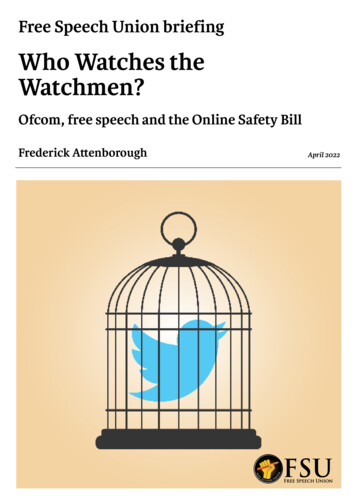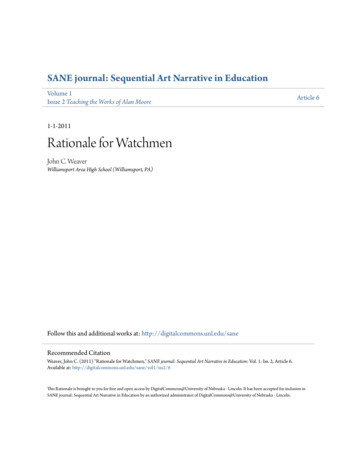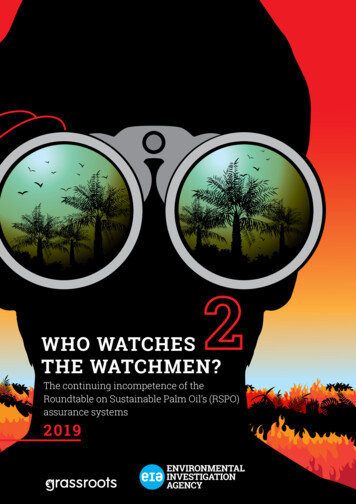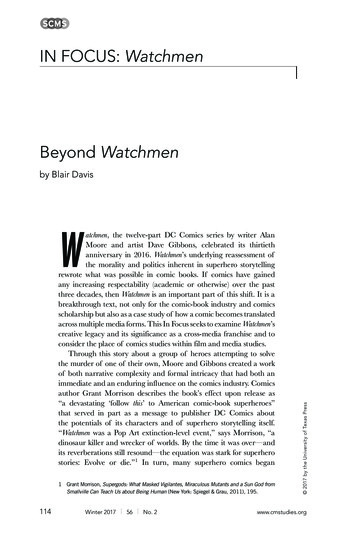
Transcription
Who Watches the Watchmen?Local News and Police Behavior in the United States*Nicola MastroroccoArianna OrnaghiTrinity College DublinHertie SchoolAugust 31, 2021AbstractDo U.S. municipal police departments respond to news coverage of local crime? We addressthis question exploiting an exogenous shock to local crime reporting induced by acquisitions oflocal TV stations by a large broadcast group, Sinclair. Using a unique dataset of 8.5 millionnews stories and a triple differences design, we document that Sinclair acquisitions decreasenews coverage of local crime. This matters for policing: municipalities that experience thechange in news coverage have lower violent crime clearance rates relative to municipalities thatdo not. The result is consistent with a decrease of crime salience in the public opinion.JEL Codes: K42, D73Keywords: Police, Local News, Clearance Rates, Sinclair* NicolaMastrorocco: n.mastrorocco@tcd.ie; Arianna Ornaghi: ornaghi@hertie-school.org. We thank DaronAcemoglu, Charles Angelucci, Ashna Arora, Elliott Ash, Sebastian Axbard, Jack Blumenau, Julia Cage, Livio DiLonardo, Mirko Draca, Ruben Durante, James Fenske, Selim Gulesci, Massimo Morelli, Tobias Nowacki, Ben Olken,Aurelie Ouss, Cyrus Samii, James Snyder, Jessica Stahl, Stephane Wolton, and seminar and conference participants atthe ALCAPONE-LACEA Workshop, Bologna, Bocconi, City University of London, the Economics of Crime OnlineSeminar, Glasgow, the Galatina Summer Meetings, the Hertie School, the IEB Political Economy Workshop, LSE, theNBER SI Political Economy, NEWEPS, the OPESS Online Seminar, the Oslo Political Economy Workshop, Petralia,Rochester, TDC, and Warwick for their comments and suggestions. Matilde Casamonti, Yaoyun Cui, Federico Frattini,and Doireann O’Brien provided excellent research assistance. We received funding for the project from the BritishAcademy and the Political Economic and Public Economics Research Group at the University of Warwick.1
1IntroductionLaw enforcement is one of the most important functions of U.S. local governments, yet we have alimited understanding of what factors shape the incentive structure of police departments (Owens(2020)). Recent years have seen an increased debate on the extent to which civil society is ableto influence the behavior of police officers. In this paper, we investigate a force that might have arole to play in this respect: local media. Focusing on local TV news, we find that the police areresponsive to changes in news coverage of local crime.Local media, and local news in particular, might influence the behavior of public officials throughtwo main channels. First, by providing information to the public, the news facilitates monitoring(Ferraz and Finan (2011), Lim et al. (2015), Snyder Jr and Strömberg (2010)). This is especiallytrue at the local level, where the news garners high levels of trust (Knight Foundation (2018)) andserves as one of the few democratic watchdogs (Rolnik et al. (2019)). Second, what news the mediacover influences perceptions of topics that are salient in the political debate (DellaVigna and Kaplan(2007), Martin and Yurukoglu (2017), Mastrorocco and Minale (2018)), potentially affecting thedemand for specific policies (Galletta and Ash (2019)).Studying the relationship between local news and the police is especially interesting for tworeasons. The first has to do with media content and the fact that local news focuses on a topicclosely intertwined with policing: crime. In local TV news—the focus of our study—crime isthe most popular topic, appearing in almost 25% of all local stories. This makes local newsuniquely positioned to influence how the public perceives police behavior. The second has to dowith police departments themselves. Because of protections coming from strong union contractsand civil service laws, the organizational structure of police departments creates barriers to theirresponsiveness to the public. As a result, how the police respond to external incentives is an openquestion.The specific research question that we ask is how a decline in TV news coverage of local crimeimpacts the behavior of police officers. Our proxy for police behavior are clearance rates, i.e. crimes2
cleared over total crimes.1 To get exogenous variation in the probability that local crime is coveredby local TV news, we exploit the fact that, in the last ten years, the local TV market has seen alarge increase in concentration driven by broadcast groups acquiring high numbers of TV stations,and that acquisitions are likely to affect content (Stahl (2016)). We focus in particular on the mostactive group in this sense: Sinclair.Sinclair acquisitions affect content in two ways. First, Sinclair reduces local news in favor of anational focus (Martin and McCrain (2019)). This gives us variation in news coverage of localcrime, which is the change in content we are interested in studying. In addition to this, however,Sinclair—a right-leaning media group—also makes content more conservative. This means thata differences-in-differences design exploiting the staggered timing of Sinclair entry across mediamarkets would not be appropriate to answer our research question, as it would not allow us toseparately identify the effect of the two changes in content.To address this challenge, we rely on the fact that the relevant geography for local TV stations isthat of a media market, which by definition is a region where all households receive the same TVstation offerings. This means that once Sinclair acquires a station, all municipalities in that station’smedia market experience its conservative messaging. However, not all municipalities are equallyexposed to the shock in news coverage of local crime.The proxy for exposure that we use is the baseline probability that a municipality is covered inthe news.2 The intuition for this is that, if Sinclair acquisitions decrease local news coverageas we hypothesize, municipalities often in the news at baseline (covered municipalities) shouldbear the brunt of the decline. Instead, municipalities that were never in the news in the first place(non-covered municipalities) are also not going to be covered after Sinclair acquires a station: theydo not experience any change in their news coverage of local crime.1 More precisely, clearance rates are defined as total number of crimes cleared by arrest or exceptional means overtotal number of crimes. A crime is considered cleared if at least one person has been arrested, charged, and turned overfor prosecution or if the offender has been identified, but external circumstances prevent an arrest. Clearance rates arehighly sensitive to what resources are allocated to investigations and have often been used by economists to study policebehavior (see, among others, Mas (2006), Shi (2009), and Premkumar (2020)).2 More precisely, we define covered municipalities as municipalities mentioned in the news more than the medianmunicipality in 2010.3
Our empirical strategy is a triple differences design that combines variation from the staggeredtiming of Sinclair acquisitions with cross-sectional variation across municipalities in whether theyare covered by the news at baseline. In other words, we estimate the effect of a decline in theprobability that a municipality appears in the news with a crime story on the violent crime clearancerate by focusing on the relative effect of the Sinclair entry on covered municipalities, that experienceboth Sinclair’s conservative slant and a large decline in the probability that their local crime eventsappear in the news, and non-covered municipalities, that also experience Sinclair’s conservativeslant but no change in the probability that their crime events appear in the news.For this to identify a causal effect, covered and non-covered municipalities must be on paralleltrends leading up to Sinclair’s entry. We provide evidence supporting this assumption using anevent study specification that allows the relative effect of Sinclair in covered and non-coveredmunicipalities to vary in time since and to treatment. In addition, Sinclair’s acquisitions must not bedriven by differential trends in the two types of municipalities. We provide suggestive evidencethat this is the case by looking at cases in which Sinclair acquires stations in a bundle (namely, byacquiring a smaller broadcast group), where entry is less likely to be endogenous to a specific mediamarket’s condition.We begin by characterizing in detail how Sinclair acquisitions affect news coverage of local crime.We do so using a novel dataset containing the transcripts of almost 8.5 millions stories in 300,000newscasts. These data allow us track news coverage of 325 stations weekly from 2010 to 2017,which represents a significantly larger time and geographic coverage with respect to previous studiesof local TV news content (see, for example, Moskowitz (2021)).We use these data to quantify the change in coverage of local crime induced by Sinclair acquisitions.To do so, we identify crime stories using a pattern-based sequence-classification method that labelsa story as being about crime if it contains a "crime bigram." That is, if it contains two wordcombinations (i.e. bigrams) that are much more likely to appear in crime-related stories of theMetropolitan Desk Section of the New York Times than in non-crime related ones. In addition, weassign stories to municipalities based on mentions of the municipality’s name.4
We find that ownership matters for content: once acquired by Sinclair, local TV stations decreasenews coverage of local crime. In particular, covered municipalities are 2.1 percentage pointsless likely to be mentioned in a crime story after a station gets acquired by Sinclair compared tonon-covered municipalities. The effect is significant at the 1% level and economically important,corresponding to almost 25% of the baseline outcome mean. Examining the timing of contentchanges, we find a reduction in local crime coverage in the year that immediately follows theacquisition, with the effect increasing over time. Other stations in the same media market do notchange their crime coverage after Sinclair entry: the main result is explained by an editorial decisionof Sinclair.How does the change in news coverage of local crime impact clearance rates? We estimate thatafter Sinclair enters a media market, covered municipalities experience 3.4 percentage points lowerviolent crime clearance rates relative to non-covered municipalities. The effect is significant at the5% level, and corresponds to 7.5% of the baseline mean. This shows that there is scope for externalforces to exert an influence on police behavior, despite the strong protections that police officers getfrom strong union contracts and civil service laws.Using an event study specification, we find no difference between covered and non-covered municipalities in the four years before Sinclair enters the media market. The effect appears withinthe first year after treatment and becomes smaller over time, which is potentially consistent with arational learning model in which viewers learn that the signal on local crime that they receive fromSinclair is biased over time, and adjust for it based on their own observation or other media sources(DellaVigna and Kaplan (2007)).3In contrast, property crime clearance rates do not experience a similar decline. This heterogeneitycan be explained by the fact that local TV news has a clear violent crime focus. We document thisin our data by training a classifier model to identify whether local crime stories are about a violentor a property crime. We show that 91% of the stories are about a violent crime and only 17% are3 Wealso provide evidence of the robustness of our estimates when taking into account concerns of heterogeneoustreatment effect with two way fixed effects estimators (de Chaisemartin and D’Haultfœuille (2020)).5
about a property crime (8% are about both), a difference which is even starker if we consider thatproperty crimes are more common by orders of magnitude. Our unique content data underpin oneof the most novel contributions of this paper: the ability to characterize in detail the content shockand precisely map content into the real-word outcomes we are interested in studying.The effect on the violent crime clearance rate is not explained by changes in violent crime rates.However, we find that, after Sinclair entry, covered municipalities have higher property crime ratesrelative to non-covered municipalities. This can be explained by a decreased incapacitation ordeterrence effect due to the lower clearance rates. Finally, we do not find evidence of the decreasein crime coverage affecting police violence, although we cannot draw strong conclusions becauseof the imprecision of our estimates.We propose the following explanation for our results. When stories about a municipality’s violentcrimes are less frequent, crime loses salience in the eyes of local citizens and the police findthemselves operating in a political environment where there is less pressure to clear violent crimes.4As a result, they might reallocate their resources away from clearing these crimes in favor of otherpolicing activities. Three pieces of evidence are consistent with this explanation. First, we use dataon monthly Google searches containing the terms "crime" and "police" to show that indeed, afterSinclair enters a media market, the attention given to these issues decreases. Second, exploitingsurvey data from Gallup, we find that, after Sinclair entry, it is less likely that individuals reportcrime to be the most important problem facing the country in covered relative to non-coveredmunicipalities. Third, we note that the key audience of local news, individuals over 55 years of age,are also an important interest group for local politics and law enforcement in particular (Goldstein,2019). Consistent with this, we find that the effect is driven precisely by those municipalitieswhere individuals over 55 years of age constitute a larger share of the population. We interpret thisevidence as supporting the idea of a feedback mechanism from salience to police behavior through4 Crime news are one of the most important determinants of salience of crime, more so than actual crime rates (seeRamırez-Alvarez (2021), Shi et al. (2020) and Velásquez et al. (2020)). In addition, Mastrorocco and Minale (2018)show using data from Italy that, when exposed to less crime related news, individuals become less concerned aboutcrime.6
citizens’ and politicians’ pressure.Alternatively, it is possible that the effect might be explained by explicit monitoring of the police.If police officers anticipate a lower probability of appearing in the news if they fail to solve acrime, they might shirk. We find this explanation to be less convincing because the decline in crimereporting is almost entirely driven by stories about crime incidents as opposed to stories that arearrest-related, thus not changing the probability of delays in solving a crime being the subject ofa story. The same result also suggests that it is unlikely that perceptions of police are negativelyaffected by the content change, which makes it unclear why community cooperation with the policeshould be affected by Sinclair entry. In addition, we argue that the magnitude of the effect on violentcrime clearance rates is not consistent with a decline in tips being the main driver of the effect.Finally, we consider whether the pattern we observe could be explained by Sinclair’s conservativeslant rather than by the change in news coverage of local crime, but we show several pieces ofevidence that are not in line with this interpretation.A long tradition in the economics of media shows that the media influence the behavior of public officials. By providing information on current events, the media performs a monitoringfunction (Ferraz and Finan (2011), Lim et al. (2015), Snyder Jr and Strömberg (2010)). In addition, media content impacts individuals’ beliefs and voting decisions (DellaVigna and Kaplan(2007), Durante et al. (2019), Durante and Knight (2012), Martin and Yurukoglu (2017),Spenkuch and Toniatti (2018)). We contribute to this literature in three ways. First, our extensive content data, which span multiple years and include a large share of TV stations, allow us toprecisely document and quantify the content changes and their timing following acquisitions. As aresult we can exactly map how content influences policy. Second, by focusing on the relationshipbetween the media and the police, we show that media content has the potential to influence evenan institution not generally considered to be responsive to external forces. Third, in the discussionof the mechanisms, we provide evidence on how media-induced changes in perceptions may feedback into the behavior of public officials. The two papers that are closest to ours in this respect areGalletta and Ash (2019) and Ash and Poyker (2019), which study how FOX News influences local7
government spending and judges’ sentencing decisions; they also show that the way in which themedia influence preferences might have a policy impact. We add to these papers by studying therole played by crime perceptions in influencing police behavior.One of our most policy-relevant findings is that ownership of local TV stations affects contentin a way that is consequential for public officials: the trend of increasing concentration, whichcurrently characterizes not only the local TV industry but also other media types such as newspapers(Hendrickson (2019)), might have tangible externalities (Prat (2018), Stahl (2016), Angelucci et al.(2020)). This questions the use of standard criteria in competition and antitrust regulation of mediaindustries (Rolnik et al. (2019)). Consistent with Martin and McCrain (2019), we confirm thatSinclair acquisitions lead to a crowding out of local news in favor of national stories. We add to thispaper by investigating the consequences of this shift for the behavior of police officers.Finally, we contribute to the growing literature aimed at understanding the determinants of police behavior (see, among others, Ba (2018), Chalfin and Goncalves (2020), Dharmapala et al.(Forthcoming), Grosjean et al. (2020), Mas (2006), McCrary (2007), Stashko (2020)) and therole played by institutional level incentives in particular (Goldstein et al. (2020), Harvey (2020),Makowsky and Stratmann (2009)). To the best of our knowledge, ours is one of the first studiesto provide systematic causal evidence on how crime news influences the police. It is particularlyinteresting to contrast our finding that a reduction in news coverage of local crime decreases clearance rates with the evidence that increases in monitoring following scandals can sometimes havethe same effect (Ba and Rivera (2019), Premkumar (2020), Devi and Fryer Jr (2020)). The tworesults can be rationalized by the attention change being of a very different nature: negative outsidepressure following scandals is likely to be very different than increases in crime salience driven bymedia coverage of crime incidents.The remainder of the paper proceeds as follows. In the next section we present the background, inSection 3 the data, and in Section 4 the empirical strategy. The main results of the effect of Sinclairon local news are in Section 5, and the results of the effect of Sinclair on police behavior are inSection 6. Section 7 discusses potential mechanisms. Finally, we conclude in Section 8.8
2Background2.1Institutional SettingA media market, also known as designated market area (or DMA), is a region where the populationreceives the same television and radio station offerings. Media markets are defined by Nielsen basedon households’ viewing patterns: a county is assigned to the media market if that media market’sstations achieve the highest viewership share.5 As a result, media markets are non-overlappinggeographies. In each market, we focus on stations that are affiliated to one of the big-four networks(ABC, CBS, FOX, and NBC) as they they tend to take up most of the viewership and be the onesproducing local newscasts.6 In fact, 85% of local TV stations that do so belong to this category(Papper, 2017).2.2Local TV NewsAlthough its popularity has been declining in recent years, local TV news remains a central sourceof information for many Americans. In a 2017 Pew Research Center report, 50% of U.S. adultsmentioned often getting their news from television, a higher share than those turning to onlinesources (43%), the radio (25%), or print newspapers (18%) (Gottfried and Shearer, 2017). AmongTV sources, news stories airing on local TV stations have larger audiences than those on cable or onnational networks (Matsa, 2018).In addition, the overarching narrative regarding the decline in TV news masks substantial heterogeneity. First, the decrease in viewership has been limited outside top-25 media markets(Wenger and Papper, 2018). In fact, local TV news still plays an important role in small andmedium sized markets, both in terms of viewership and because there tend to be fewer outlets suchas newspapers producing original news focusing on the area (Wenger and Papper, 2018).5 Countiescan be split across media markets, but this happens rarely in practice. As noted by Moskowitz (2021),only 16 counties out of 3130 are split across media markets. Similarly, while media markets are redefined by Nielsenevery year, only 30 counties changed their media market affiliation between 2008 and 2016.6 Networks are publishers that distribute branded content. Affiliated stations, although under separate ownership,carry the television lineup offered by the network while also producing original content. With few exceptions, eachnetwork has a single affiliate by media market.9
0.2580.250.2960.252Mean Topic Share (Local News)0.100.150.200.2050.139Crime StoriesLocal Crime StoriesLocal Crime Stories0.1600.1250.05Local Stories.05Share of Stories of a Given Type.1.15.2.25.3Figure I: Local TV News ContentCrimePoliticsWeatherSports00.00Misc.(a) Types of News Stories(b) Local News TopicsNotes: This figure describes local TV news content. Panel (a) shows the share of stories that are local, that are about crime, and both local andabout crime. A story is local if it mentions at least one of the municipalities with more than 10,000 people in the media market. A story is aboutcrime if it contains a "crime bigram" (i.e. a bigram that is much more likely to appear in crime-related stories than in non-crime related ones of theMetropolitan Desk Section of the New York Times). For more details, see Section 3. Panel (b) shows the mean topic share from an unsupervisedLDA topic model trained on local stories. In both graphs, the sample is restricted to media markets that never experienced Sinclair entry.Second, the decline has been concentrated in younger demographics, while the core audienceof local TV news – those above 50, who constitute 73% of the viewership – has not been beenaffected (Wenger and Papper, 2018). Considering that local TV news also tends to garner thehighest levels of trust from the public (Mitchell et al., 2016), it constitutes an important source thathas the potential to shape public information and perceptions.What is local TV news about? Our novel content data allow us to provide a precise answer to thequestion. Newscasts of local TV stations include both national and media market-specific stories.As we show in Figure I Panel (a), approximately 30% of stories are specific to the media market,in that they mention at least one same media market municipality with more than 10,000 people.Crime is a prime subject of local TV news: 22% of local stories are crime-related (13% overall).7To have a more complete picture of the breakdown of topics covered in local TV news, we also trainan unsupervised LDA model with five topics on the 2 million local stories in our content data.8 InFigure I Panel (b), we show the average topic shares across all local news stories. Again, apart from7 We discuss in detail the content data and the methodology we use to identify local stories and crime stories in thefollowing section.8 Appendix Figure I shows word clouds with the 50 words that have the highest weight for the five topics. Four ofthe five topics can be easily identified to be related to crime, politics, weather, and sports. The last topic appears to be amiscellaneous topic with no clear meaning.10
a miscellaneous topic with no clear meaning, the most covered topic is crime (with a topic share of25%), followed by politics (20.5%), weather (16%), and sports (12.5%). Given the crime focus ofTV newscasts, studying the relationship between local news and police departments appears to befirst order.2.3The Sinclair Broadcast GroupSince 2010, the local TV market has seen the emergence of large broadcast groups owning asignificant share of local TV stations (Matsa, 2017). We focus on one of the most active players inthe local TV market: the Sinclair Broadcast Group. Figure II Panel (a) shows the number of localTV stations under Sinclair control monthly from 2010 to 2017. Sinclair expanded from 33 stationsin January 2010 to 121 stations in December 2017, which corresponds to about 14.5% of all big-fouraffiliates. As shown in Figure II Panel (b), there have been acquisitions in media markets across theUnited States, although Sinclair was particularly active in medium-sized media markets. Given thatthe Federal Communications Commission restricts the number of stations that a single entity cancontrol in each media market, Sinclair acquisitions generally correspond to Sinclair owning one outof the four stations we consider.9With respect to other broadcast groups, Sinclair holds a right-leaning political orientation (seeMiho (2020) for a detailed discussion) and it appears to be particularly interested in controlling themessaging of its stations (Fortin and Bromwich (2018)). Importantly, after acquisitions, stationsmaintain their call sign, network affiliation, and news anchors: it might take time for viewers torealize that content has changed.Existing research supports the anecdotal evidence. Martin and McCrain (2019) show using adifferences-in-differences design that when Sinclair acquired the Bonten Media Group in 2017, theideological slant of Bonten stations moved to the right. Miho (2020) shows that Sinclair’s conservative leaning might have real word effects, with exposure to Sinclair-owned stations increasing theRepublican vote share in presidential elections. In addition, Martin and McCrain (2019) also show9Asingle entity can control at most two stations in a media market provided that the signal areas of the stations donot overlap, or at least one of the stations is not among the four with the highest audience share.11
020# of Stations Controlled by Sinclair406080100120140Figure II: Sinclair Acquisitions over Time and Space20102011201220132014201520162017(b) Media Markets Experiencing Sinclair Entry(a) Number of Stations Controlled by SinclairNotes: Panel (a) shows the number of big-four affiliate stations controlled by Sinclair in each month from January 2010 to December 2017. Astation is considered controlled by Sinclair if it is owned and operated by the Sinclair Broadcast Group, if it is owned and operated by CunninghamBroadcasting, or if Sinclair controls programming through a local marketing agreement. Panel (b) shows year of Sinclair entry across media marketsin the United States. Lighter colors correspond to later entry. Never treated are media markets that never experience Sinclair entry; always treatedare media markets that have at least one station controlled by Sinclair at the beginning of the period of interest (January 2010). There were noadditional stations that were acquired in 2010.that Sinclair acquisitions increase national coverage mostly at the expense of local stories. Thesecontent changes have limited negative effects on viewership, at least in the short run.2.4Municipal Police DepartmentsLaw enforcement in the United States is highly decentralized. Municipal police departments are theprimary law enforcement agency in incorporated municipalities: they are responsible for respondingto calls for service, investigating crimes, and engaging in patrol within the municipality’s boundaries.Municipal police departments are lead by a commissioner or chief that is generally appointed (andremoved at will) by the head of the local government. For more details on the functioning of lawenforcement agencies in the United States see Appendix A.3Data and MeasurementThis paper combines multiple data sources.Station Data. Our starting sample are 835 full-powered commercial TV stations that are affiliatedto one of the big four networks (ABC, CBS, FOX, and NBC).10 Information on the market served10 Asdiscussed in Section 2.1, this choice is motivated by the fact that these stations tend to have the largest viewershares and produce their own newscasts.12
by each station and yearly network affiliation 2010-2017 is from from BIA/Kelsey, an advisory firmfocusing on the media industry.Sinclair Ownership and Control. Information on Sinclair control is from the group’s annualreports to shareholders. In particular, we collect information on the date on which Sinclair tookcontrol over the station’s programming. When the annual reports do not allow us to determine theexact date of take-over, we recover this information from the BIA/Kelsey data, which include thefull transaction history of all stations in the sample.11 We consider stations to be controlled bySinclair if they are owned and operated by the Sinclair Broadcast Group, if they are owned andoperated by Cunningham Broadcasting, or if Sinclair controls the station’s programming througha local marketing agreement.12 We use Sinclair acquisitions to refer to
Who Watches the Watchmen? Local News and Police Behavior in the United States* Nicola Mastrorocco Trinity College Dublin Arianna Ornaghi Hertie School August 31, 2021 Abstract Do U.S. municipal police departments respond to news coverage of local crime? We address this question exploiting an exogenous shock to local crime reporting induced by .










